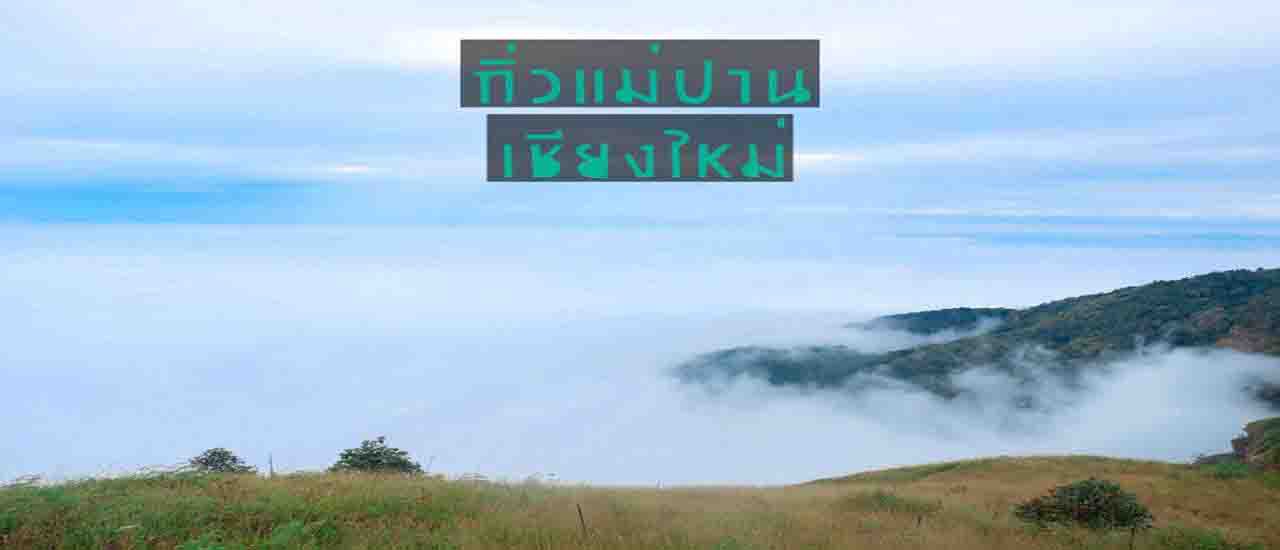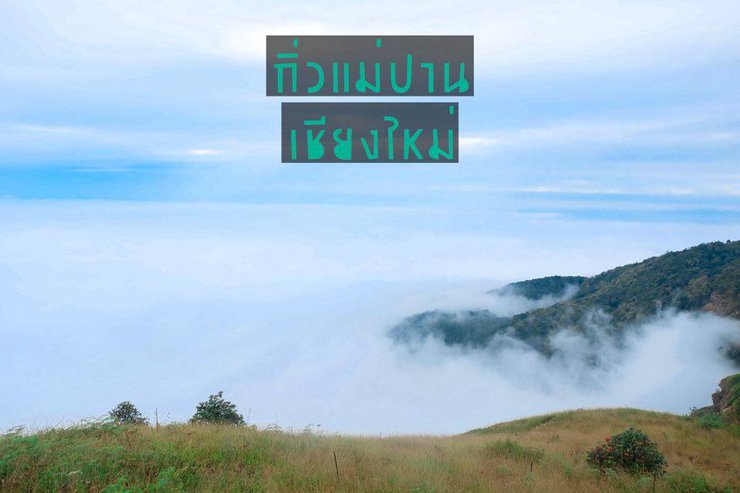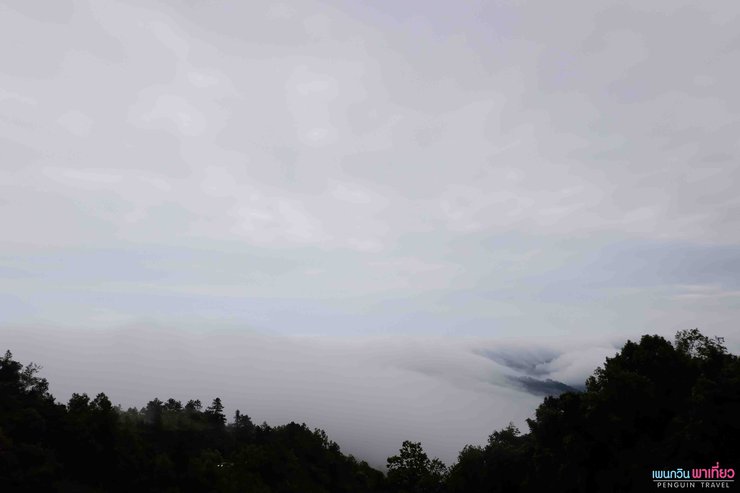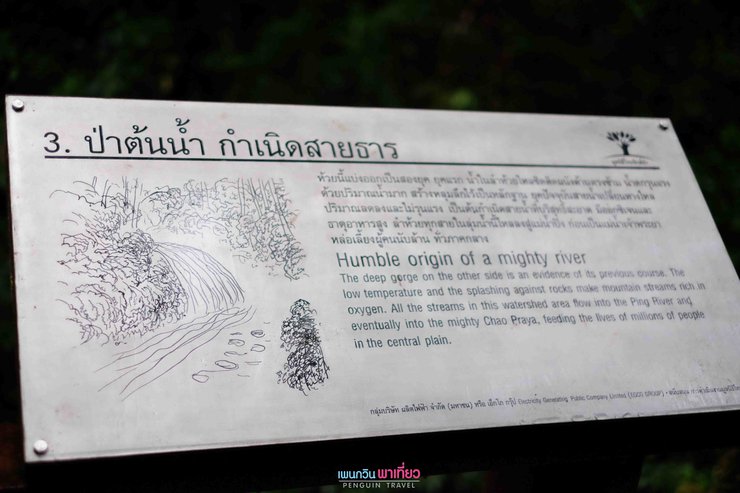
Day 5 of the Chiang Mai Trip
The fifth day of our trip will be spent hiking at "Kiew Mae Pan," a nature trail. The journey from Doi Chaung Ya takes approximately 20 minutes. The morning weather is foggy with light rain. The trail follows Highway 1009 (Jom Thong - Doi Inthanon).
Embark on a journey with a penguin as your guide, dragging your luggage along the way.
Penguin Travel TH
Review Travel Trip
http://pantip.com/topic/36053234 Chiang Mai Day 5: Kew Mae Pan, Doi Inthanon, Naphamethinidon Naphaphonphumisiri
http://pantip.com/topic/36042631 Chiang Mai Day 4: Khun Wang, Doi Chaua Na, beautiful view
http://pantip.com/topic/36028228 Chiang Mai Day 3: Mae Kampong Village, Opium Trail @ Huen Uai Homestay
http://pantip.com/topic/36022591 Chiang Mai Day 2: Wat Phra That Doi Suthep, Mon In Dao @ Le SIRI at Ruamchok Accommodation
http://pantip.com/topic/36020904 Chiang Mai Day 1: Walking Street Tha Pae Gate @ The Home Chiang Mai Hostel
http://pantip.com/topic/35591383 Chanthaburi: Pink Stone Beach, Ao Kung Kraben Mangrove Forest @ Hug the Sea Resort
http://pantip.com/topic/35562672 Chanthaburi: Rim Nam Chanthaboon, Viewpoint of Nang Phaya Hill @ Accommodation Krathing Country Resort
http://pantip.com/topic/35250908 Surat Thani: Koh Phangan, Koh Ma, Talay Waek @ Phangan Utopia Resort
http://pantip.com/topic/35282975 Chonburi: Koh Samae San (one-day trip)
http://pantip.com/topic/34998253 Surat Thani: Koh Tao, Koh Nang Yuan @Jom Thong Guest House @Au Aon Guest House
http://pantip.com/topic/35066637 Chonburi: Koh Larn @Way Hotel
http://pantip.com/topic/35075205 Chonburi: Koh Sichang (one day trip)
Review the English version of the "ทริปท่องเที่ยว" document on Readme.me.
https://en.readme.me/p/3243 (Koh Tao Ver.ENG)
Restaurant and cafe reviews
HYDE Cafe (Happy Your Drink Every Day)
http://pantip.com/topic/35189946 Kyo Roll En Restaurant
http://pantip.com/topic/35169908 Melt Me Fresh Hokkaido Chocolate & Gelato Shop
http://pantip.com/topic/35140467 Farm Design Shop
Review and Photo by Adisak J.
https://www.facebook.com/penguintravelth/ <<< Follow our travels on the Penguin Travel page
Day 5
EP.1 "Kiew Mae Pan"
Kiw Mae Pan is a nature study trail covering a distance of 3.2 kilometers.
At an altitude of approximately 2,200 meters above sea level, there are a total of 21 bases with stairs to walk along the ridge at intervals.
The journey takes approximately 3 hours. Along the way, you will be surrounded by lush cloud forests, diverse plant life, and unique flowers.
To embark on the nature trail of Kiw Mae Pan, prior registration is required. The guide fee is 200 baht per group of 10 travelers.
The park is open daily from 6:00 AM to 4:00 PM. (The last group is allowed to enter no later than 4:00 PM.)
Open from November 1st to May 31st of each year (closed from June 1st to October 31st to allow nature to recover).


At a comfortable 11 degrees Celsius, we embarked on our journey with "Nong Win" as our guide, who led us through the 21 points of interest, explaining their history and significance.



The first point, "Ancient Ferns," marks the origin of ferns in the ancient past. Ferns are plants with ancestors dating back to the Paleozoic era, as evidenced by fossils discovered by scientists. Ferns predate all land animals.


Point 2: "Cloud Forest" - A type of tropical montane rainforest where the environment facilitates the formation of clouds and mist that blanket the area.
The cloud forest is characterized by its high density of moss, ferns, orchids, and epiphytes growing on trees and rocks.


Point 3: "Forest Headwaters, the Origin of Streams" This point is the source of water that is the origin of the main river basins of Thailand.


Point 4: "Pann Phim Pa Maek" is densely covered with moss, ferns, and orchids on the branches of the trees, on both sides of the surrounding trees.




Point 5, "Forest Repairing Forest," is a cloud forest with strong winds that have caused trees to fall, creating open spaces where some sunlight can penetrate.
Allowing sunlight to reach the fallen trees in the forest encourages the growth of heliophilic pioneer species, facilitating natural forest regeneration through the cycle of nature.





Point 6: "Vine" Vines thrive in full sunlight, with consistent lateral growth but continuous vertical growth. Vines climb through large forests, spreading their leaves among the treetops. Squirrels and other tree-dwelling animals often use vines as pathways.



Point 7: "Cold Grassland" - Subalpine grasslands are a unique phenomenon occurring on Doi Inthanon, Doi Pha Hom Pok, and Doi Chiang Dao.
(2,000 - 2,500 meters high) provides coolness to the fallen trees mixed with small shrubs.


Point 8: "Goudkie ferns" are fire-resistant ferns with deep underground rhizomes and tripinnate leaves. They are resistant to fire and burning.








Point 9, "Scenic Viewpoint," is a popular spot for capturing stunning photos of the sea of mist.

Point 10: "Gaur: Safe in the Rocky Home." Gaur are social animals that prefer to live in meadows on mountains and cliffs in high mountain ranges. Currently, the Doi Inthanon gaur is an endangered species. Tourists rarely have the opportunity to encounter them.



Point 11, "Pha Ngam Noi," is a granite rock formation that formed 200 million years ago when molten granite intruded into older gneiss rock, which is over 500 million years old. As the granite cooled, cracks appeared on the opposite side, resulting in weathering and erosion. Consequently, the harder granite of Pha Ngam Noi has endured, becoming a prominent landmark and symbol of Kiew Mae Pan.


Point 12: "Kiew Mae Pan (Two-Cornered Forest on the Ridge)" "Kiew" in the northern language means narrow. "Kiew Mae Pan" is the narrowest part of the ridge. The slopes on both sides are different types of forests. The outer side is exposed to the sun and strong winds, and there are only small trees. The inner side is a humid forest.





Point 13: "Rose of the Andes" adapts to survive in cold and windy climates. Its leaves are thick and leathery, reducing water loss. Its branches are open, allowing wind to pass through easily. The flowers are dark red and bloom between December and March.





Point 14, "Hot Forest, Cold Forest," is located at the foot of Doi Inthanon. The air at the foot of the mountain is hot and humid, while the summit is cold, windy, and foggy. Due to the different environments, the hot forest has broad-leaved trees that prefer full sun and are drought-tolerant. The cold forest, on the other hand, has low-lying shrubs with waxy leaves. From this point, we can see the two pagodas, Naphamethinidon and Naphaphonphumisiri. The viewpoint for the two pagodas is located between points 14 and 15.







Point 16: "Moss likes water but can withstand drought." Moss often grows at the base of trees and in humid places. During the dry season, it goes dormant and waits for moisture to return. It can reproduce by spores.


Point 17: "Two-generation forest" - This forest contains trees of various species, ages, and heights, indicating that it was previously felled by a storm, allowing a new generation of trees to grow simultaneously.


Along the way, we also encountered a blue beetle.



Point 18: "Tall but easily toppled" - The steep slopes of the mountains have thin topsoil, only 1-2 meters thick, due to erosion from rainwater. The underlying layer is rock. Tall trees often lack taproots because they cannot penetrate the rock. During strong storms, these trees are easily toppled.


Point 19: "Gutta, the fern symbolizing pristine forest." Gutta is a fern with large leaves arranged in a circle around the top of the plant. It has a wide canopy and is only found in moist, shaded areas along streams and rivers. The absence of Gutta in sunny areas suggests that it is a symbol of pristine forest.



Point 20, "Sounds of the Forest," is a place where we can sit, relax, and close our eyes to listen to the sounds of the forest.

Point 21: "Conclusion" - Guide Win provided a brief summary. The natural journey of Kew Mae Pan involves both ascents and descents, with varying degrees of difficulty. This is analogous to human life, which also has its ups and downs. Life is impermanent and unpredictable.

Thank you to our guide, Win, and to all the fellow travelers who joined us on this journey.
Day 5
EP.2 "Doi Inthanon, Naphamethinidon and Naphaphonphumisiri"
The distance from Kiw Mae Pan to Doi Inthanon is approximately 6 kilometers. At the summit, there is a shrine dedicated to King Inthawichayanon.






We have reached the highest point of Siam after a five-day journey filled with diverse experiences. We will now descend to the city of Chiang Mai, stopping along the way to pay our respects at the Naphra Mahathat Naphmethinidon Naphaphonphumisiri.

The Naphra Mahathat Naphmethinidon Naphaphon Phumisiri is located on the way down to Chom Thong district, near the Kiw Mae Pan route.
Opening hours are from 08:00 to 17:00 with an entrance fee of 40 Baht per person.
The Great Relics of Naphamethinidon and Naphaphonphumisiri
Located 500 meters beyond the viewpoint on the left side of the road leading up to Doi Inthanon at kilometer 41.5, the twin pagodas were constructed by the Royal Thai Air Force in collaboration with the Thai people. The Naphamethinidon Pagoda was built to commemorate the 5th cycle birthday anniversary of His Majesty the King in 1987, while the Naphaphonphumisiri Pagoda was built to celebrate the 5th cycle birthday anniversary of Her Majesty the Queen in 1992. Both pagodas share a similar design, featuring a 12-sided base with two levels of glass balconies that house relics of the Buddha and Buddha statues. The surrounding area offers breathtaking panoramic views of Doi Inthanon.
The two grand stupas were constructed: Naphra Meru, dedicated to King Bhumibol Adulyadej on the occasion of his 5th cycle birthday anniversary in 1987, and Naphra Naphol Bhumisiri, dedicated to Queen Sirikit on the occasion of her 5th cycle birthday anniversary in 1992.
The structure resembles a 12-sided base with a two-level glass balcony surrounding it. The spire houses the relics of the Buddha and a Buddha statue for worship. The surrounding area offers stunning views of Doi Inthanon.
Source: http://www.chiangmaipao.go.th/tourism/index.php




Between the two great stupas, there is a botanical garden showcasing beautiful plants.















From Phra Maha Chedi Na Pom Methanidon - Na Pom Phumisiri - Mueang Chiang Mai, take the route Chom Thong >> San Pa Tong >> Hang Dong >> Mueang Chiang Mai.
Day 5
EP.3 "Night Bazaar, Worarot, Plearnridee, Khua Lek"

Before heading back, we will take a tour of the night market. Our first stop is Kad Worarot, a market that offers a variety of souvenirs, including strawberries, sai oua (northern Thai sausage), crispy pork skin, and delicious snacks.


Rice noodles by candlelight


Spicy Northern Thai noodle soup with egg noodles, curry broth, and meat or tofu.

Following Kad Worarot, we arrive at "Plearn Rudee," a new project featuring food stalls and a beer bar. This spot attracts groups of Western tourists who come to relax and enjoy the atmosphere.
The atmosphere is perfect for enjoying drinks with friends.


A beer garden with twinkling lights, where patrons can relax on barrels and bales of hay while enjoying live music.

Steakhouse



Mango smoothie



Italian-style dishes are also available.





A bar is an establishment that serves alcoholic beverages, such as beer, to its patrons.

From Kad Pleanrindee, which is in the same zone as the Night Bazaar.




Both sides of the Night Bazaar will be handmade. The next point is "Khua Lek", a steel bridge crossing the Ping River.





Our 5-day trip has come to an end. Stay tuned for our next adventure!
Penguin Travel Page https://www.facebook.com/penguintravelth/
Light ART Production https://www.facebook.com/lightart2u/
Thank you, fellow travelers.
Adisak Jaidee
Friday, October 4, 2024 3:11 PM
















